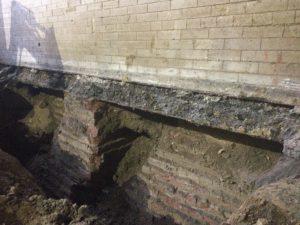KETV Historical Building Remodel
Challenge
The local ABC affiliate, KETV, acquired the historic Burlington Train Station to be remodeled as a broadcast and web-media facility. This remodel included the re-support of an interior multi-wythe brick wall. The existing wall was supported by a continuous pair of steel channels spanning approximately 10 feet between brick piers along the wall length. The design team proposed removing the steel channels to support the existing wall on a continuous grade beam and a deep foundation system. A geotechnical investigation performed for the proposed renovations included the advancement of 13 soil borings to a maximum explored depth of 95 feet below grade.
The general subsurface profile consisted of approximately 80 feet of soft to stiff lean clay underlain by 9.5 feet of sand with cobbles. The sand was underlain by a one-foot-thick layer of weathered shale over weathered limestone to the explored depth.
Solution
Helical piles were chosen as the ideal deep foundation solution given the limited access and tight working area. The helical pile configuration consisted of a square-bar “stinger” lead section, Model 200 (2.00-inch round corner square bar) with an 8”-10”-12” triple-helix arrangement, transitioning (via a special welded coupler) to a Model 350 (3.50-inch OD by 0.313-inch wall) hollow round shaft extension with a single 14” helix plate. The remaining lengths of the piles consisted of blank Model 350 extensions.
The square-to-round “stinger” lead section was used to better penetrate the cobbly sand and weathered shale, while the helix plate configuration was selected to achieve the required torque prior to “spinning off” on the limestone. The 8” and 10” helix plates were each 0.5-inch-thick and utilized a V-style cut on the leading edge to help the piles advance through the cobbles and also aid in penetrating into the anticipated shale layer. The helical piles were advanced to achieve torque-correlated ultimate capacities of at least twice the design working loads (FOS≥2). The installed piles were fitted with new construction brackets and cast into T-shaped concrete saddle beams spaced along and perpendicular to the wall.
The helical piles and saddle beams were positioned to avoid the existing brick piers. The “T” shape of the beams was required to install two helical piles on one end and a single helical pile on the other to resist the asymmetrical loading on the beams. With the saddle beams constructed, steel I-beams were placed through penetrations in the lower sections of the wall. Hydraulic jacks sitting on the saddle beams then supported the ends of the I-beams, thereby unloading the original steel channels beneath. The channels were removed and a new concrete grade beam was constructed to transfer the wall load to the saddle beams. The hydraulic jacks and steel beams were removed.
Need Our Help?
We're proud to be your local experts in deep foundations, concrete lifting, leveling and sealing, and retention systems. Interested in learning more or speaking with one of our solution specialists? Email [email protected].




